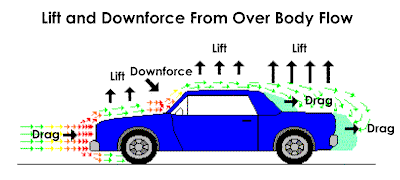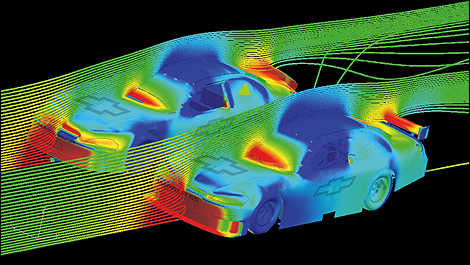Wow, there has been a lot written since I left work yesterday and I’m too busy to get to all of them specific to A2. Don't get my analogy wrong, I didn’t say the rider is an air foil, but does resemble the same shape (cambered top). The round smooth sexy curves you see and that are pleasing to the eye are not surfaces that typical of creating downforce. Those rounded shapes tend to create lift (in most cases). You are correct when saying that air is separating off the riders back, but that doesn’t automatically mean that there should be downforce (this is not an airplane). There is also a pitching moment and if the front of the bike has lift then there could be a transfer to the rear making it negative along with the separation off the riders back. The top shape is not the only component creating lift, front fender shape, air trapped between the front fender and lower fairing creates pressure differences...ect.. many variables to consider and not as simple as looking at a picture. To give you an idea here are some # of a motorcycle simular to the one in the picture
Lbs @ 190 mph (standard NACA day: sea level)
Drag = 283 lbs
Front = +134 lbs (lift)
Rear = -112 lbs (downforce)
Rex answered most of the questions but, before each run there is a wind off zero of the balance which takes the weight of the object (car or motorcycle) in addition to the balance and zeros them out. Then as the tunnel is turned on and once the air is up to speed and stable the balance is just measuring the aero effect of the object very precisely. Imagine standing on a scale and someone zeros it and then hands you a 20 lbs weight, the scale would then read 20 lbs with you standing on it. A wind tunnel balance measures in 6-components to give a drag, front lift, rear lift, front side force, rear side force, pitching moment, rolling moment, and yawing moment to give a better picture of what is happening to the entire system (vehicle). There are many interactions that happen and there might be a change in the front that could affect the rear and vise versa.
Example: NASCAR Cup series recently went from a rear wing back to the traditional spoiler. This gave the teams more downforce, but where? Most would assume that the change was to the rear so the rear was the only component that gained downforce (This is incorrect). By adding a rear spoiler the center of pressure was moved forward and there was a significant improvement on front down force from the wing allowing the cars drive better in the corners because the balance (front to rear) was improved by increasing the front percent (aero). I realize LS racers don’t turn but it is still important to have balance and not an unstable condition where the front is lifting (due to aero) and the rear is pushing down (due to aero). As some of you know, cars can have enough lift that they will become airborne.
Here are some more pictures that help illustrate


